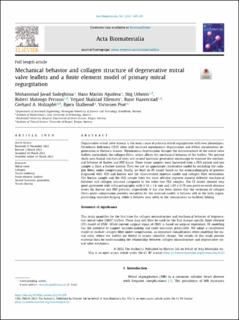| dc.contributor.author | Sadeghinia, Mohammadjavad | |
| dc.contributor.author | Aguilera, Hans Martin Dahl | |
| dc.contributor.author | Urheim, Stig | |
| dc.contributor.author | Persson, Robert | |
| dc.contributor.author | Ellensen, Vegard Skalstad | |
| dc.contributor.author | Haaverstad, Rune | |
| dc.contributor.author | Holzapfel, Gerhard | |
| dc.contributor.author | Skallerud, Bjørn Helge | |
| dc.contributor.author | Prot, Victorien Emile | |
| dc.date.accessioned | 2023-09-14T10:59:38Z | |
| dc.date.available | 2023-09-14T10:59:38Z | |
| dc.date.created | 2023-04-28T11:15:51Z | |
| dc.date.issued | 2023 | |
| dc.identifier.issn | 1742-7061 | |
| dc.identifier.uri | https://hdl.handle.net/11250/3089417 | |
| dc.description.abstract | Degenerative mitral valve disease is the main cause of primary mitral regurgitation with two phenotypes: fibroelastic deficiency (FED) often with localized myxomatous degeneration and diffuse myxomatous degeneration or Barlow’s disease. Myxomatous degeneration disrupts the microstructure of the mitral valve leaflets, particularly the collagen fibers, which affects the mechanical behavior of the leaflets. The present study uses biaxial mechanical tests and second harmonic generation microscopy to examine the mechanical behavior of Barlow and FED tissue. Three tissue samples were harvested from a FED patient and one sample is from a Barlow patient. Then we use an appropriate constitutive model by excluding the collagen fibers under compression. Finally, we built an FE model based on the echocardiography of patients diagnosed with FED and Barlow and the characterized material model and collagen fiber orientation. The Barlow sample and the FED sample from the most affected segment showed different mechanical behavior and collagen structure compared to the other two FED samples. The FE model showed very good agreement with echocardiography with 2.02 ± 1.8 mm and 1.05 ± 0.79 mm point-to-mesh distance errors for Barlow and FED patients, respectively. It has also been shown that the exclusion of collagen fibers under compression provides versatility for the material model; it behaves stiff in the belly region, preventing excessive bulging, while it behaves very softly in the commissures to facilitate folding. | en_US |
| dc.language.iso | eng | en_US |
| dc.publisher | Elsevier | en_US |
| dc.rights | Navngivelse 4.0 Internasjonal | * |
| dc.rights.uri | http://creativecommons.org/licenses/by/4.0/deed.no | * |
| dc.title | Mechanical behavior and collagen structure of degenerative mitral valve leaflets and a finite element model of primary mitral regurgitation | en_US |
| dc.type | Journal article | en_US |
| dc.type | Peer reviewed | en_US |
| dc.description.version | publishedVersion | en_US |
| dc.rights.holder | Copyright 2023 The Author(s) | en_US |
| cristin.ispublished | true | |
| cristin.fulltext | original | |
| cristin.qualitycode | 1 | |
| dc.identifier.doi | 10.1016/j.actbio.2023.03.029 | |
| dc.identifier.cristin | 2144149 | |
| dc.source.journal | Acta Biomaterialia | en_US |
| dc.source.pagenumber | 269-281 | en_US |
| dc.identifier.citation | Acta Biomaterialia. 2023, 164, 269-281. | en_US |
| dc.source.volume | 164 | en_US |

